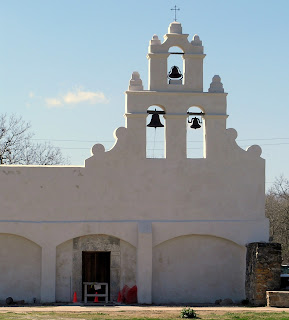Mission Concepcion
The missio of Nuestra Senora de la Purisima Concepcion was transferred from East Texas in 1731. The church look essentially as it did in the mis-1700's as the mission's center of religious activity.
The missio of Nuestra Senora de la Purisima Concepcion was transferred from East Texas in 1731. The church look essentially as it did in the mis-1700's as the mission's center of religious activity.
Mission Espada
Founded in 1690 as San Francisco de los Tejas, this oldest of the East Texas missions was moved to the San Antonio River in 1731 and there renamed San Francisco de la Espada. Espada look nearly as remote now as it in the mid 1700's.
Founded in 1690 as San Francisco de los Tejas, this oldest of the East Texas missions was moved to the San Antonio River in 1731 and there renamed San Francisco de la Espada. Espada look nearly as remote now as it in the mid 1700's.
Mission San Jose
In 1720 Fray Antonio Margil de Jesus founded the best known of the Texas missions, San Jose y San Miguel de Aguayo. San Jose was the model mission organization and a major social center. Visitors praised its unique church architecture and the rich fields and pastures. The size of the complex testifies to San Jose's reputation as the "Queen of the Missions."
In 1720 Fray Antonio Margil de Jesus founded the best known of the Texas missions, San Jose y San Miguel de Aguayo. San Jose was the model mission organization and a major social center. Visitors praised its unique church architecture and the rich fields and pastures. The size of the complex testifies to San Jose's reputation as the "Queen of the Missions."
The church was second permanent church built by mission inhabitants. Completed ca. 1792; restored 1930's.
The Rose Window is known as the premier example of Spanish Colonial ornamentation in the United States. Its sculptor and significance continue to be a mystery. Folklore credits Pedro Huizar, a carpenter and surveyer from Spain, with carving the famous windows as a monument to his sweetheart, Rosa. Tragically, on her way from Spain to join him, Rosa was lost at sea. Pedro then completed the window as a declaraion of enduring love. A less colorful, but more likely theory is that the window was named after Saint Rose of Lima, the first saint of the New World.
Shows colorful fresca that made the church very attractive
Convento - provided a residence for the missionary and lodging for visitors. Completed ca. 1755; addition 1780's; modified 1859-1868
Grist Mill at the mission was built when inhabitants began to eat more wheat than corn. Operational 1794-1809. Reopened 2001
Indian Quarters were homes for the families entering the mission. Completed ca. 1755; restored 1930's.
Cooking ovens
Bastion that gave protection against Indian attack. Reconstructed 1930's.
Mission San Juan
Mission San Juan Capistrano was originally San Jose de los Nazonis in East Texas. In 1731 it was moved to its permanent home on the San Antonio River's east bank. Its fertile farmland and pastures would soon make it a regional supplier of produce. Orchards and gardens outside the walls grew peaches, melons, pumpkins, grapes, and peppers. Its irrigated fields produced corn, beans, sweet potatoes, squash, and even sugar cane. In 1762, Mission San Juna's herds were said to number 3,500 sheep and nealy as many cattle.
























No comments:
Post a Comment